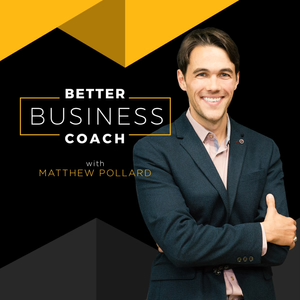
Better Business Coach Podcast: Sales Training | Proven Education | Actionable & Downloadable Worksheets
Matthew Pollard, Business Coach, Entrepreneur, Sales and Marketing Strategist
All episodes
Best episodes
Seasons
Top 10 Better Business Coach Podcast: Sales Training | Proven Education | Actionable & Downloadable Worksheets Episodes
Goodpods has curated a list of the 10 best Better Business Coach Podcast: Sales Training | Proven Education | Actionable & Downloadable Worksheets episodes, ranked by the number of listens and likes each episode have garnered from our listeners. If you are listening to Better Business Coach Podcast: Sales Training | Proven Education | Actionable & Downloadable Worksheets for the first time, there's no better place to start than with one of these standout episodes. If you are a fan of the show, vote for your favorite Better Business Coach Podcast: Sales Training | Proven Education | Actionable & Downloadable Worksheets episode by adding your comments to the episode page.
FAQ
How many episodes does Better Business Coach Podcast: Sales Training | Proven Education | Actionable & Downloadable Worksheets have?
Better Business Coach Podcast: Sales Training | Proven Education | Actionable & Downloadable Worksheets currently has 28 episodes available.
What topics does Better Business Coach Podcast: Sales Training | Proven Education | Actionable & Downloadable Worksheets cover?
The podcast is about Management, Podcasts, Business and Careers.
What is the most popular episode on Better Business Coach Podcast: Sales Training | Proven Education | Actionable & Downloadable Worksheets?
The episode title 'BBC 024 : How to Make Networking Work for You (1 of 2)' is the most popular.
What is the average episode length on Better Business Coach Podcast: Sales Training | Proven Education | Actionable & Downloadable Worksheets?
The average episode length on Better Business Coach Podcast: Sales Training | Proven Education | Actionable & Downloadable Worksheets is 18 minutes.
How often are episodes of Better Business Coach Podcast: Sales Training | Proven Education | Actionable & Downloadable Worksheets released?
Episodes of Better Business Coach Podcast: Sales Training | Proven Education | Actionable & Downloadable Worksheets are typically released every 2 days, 1 hour.
When was the first episode of Better Business Coach Podcast: Sales Training | Proven Education | Actionable & Downloadable Worksheets?
The first episode of Better Business Coach Podcast: Sales Training | Proven Education | Actionable & Downloadable Worksheets was released on Jan 31, 2015.
Show more FAQ

Show more FAQ